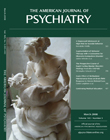Facial Emotion Labeling Deficits in Children and Adolescents at Risk for Bipolar Disorder
Abstract
Objective: Research has revealed facial emotion labeling deficits in children and adolescents with bipolar disorder. To assess whether such impairments may be an endophenotype for bipolar disorder, the authors examined facial emotion identification proficiency in children who were at risk for bipolar disorder because they had a first-degree relative with the illness. Method: The facial expressions subtests of the Diagnostic Analysis of Nonverbal Accuracy scale were administered to 52 patients with bipolar disorder, 24 at-risk youths, and 78 control subjects, all 4–18 years of age. Results: Compared with the control group, both the bipolar and at-risk groups made more errors identifying facial emotions. The number of errors did not differ significantly between the bipolar and at-risk groups. Conclusions: Deficits in facial emotion labeling may be a risk marker for bipolar disorder. Further study is needed to determine the neural mechanisms involved, as well as to explore other emotional processing impairments in youths at risk for bipolar disorder and to identify genetic associations.



